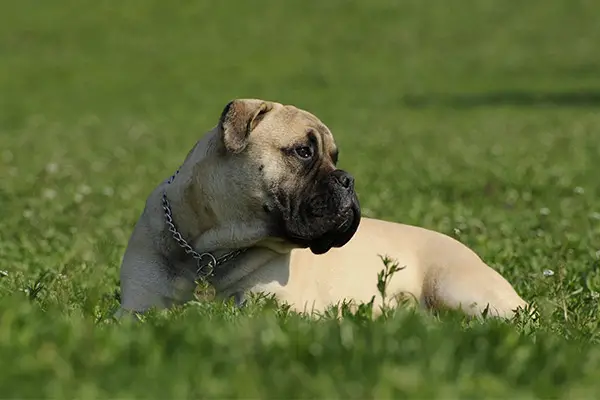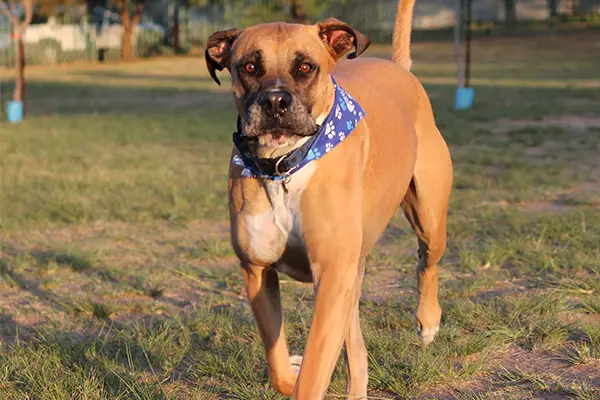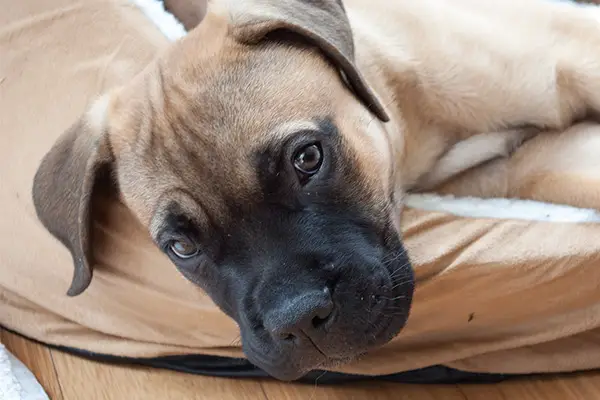The Bullmastiff is a large-sized dog breed known for being great guard dogs for lands and real estates. They have a large and muscular body covered with a short coat that comes in fawn, reddish-brown, and brindle colors. They have a wrinkled head, a short square muzzle., and v-shaped ears that hang downward.
Bullmastiffs can be intimidating at first look. They always stand alert and confident, making them very reliable guard dogs. However, besides being fearless dogs, they are excellent family pets who are good with children as well.

Bullmastiff Statistics
| Dog Breed Group | Working |
| Breed Size | Giant |
| Height | 25-27 inches (male); 24-26 inches (female) |
| Weight | 110-130 pounds (male); 100-120 pounds (female) |
| Lifespan | 7-9 years |
Bullmastiff Ratings
| Energy level | |
| Exercise needs | |
| Requires attention | |
| Playfulness | |
| Trainability | |
| Shedding | |
| Grooming | |
| Friendly with family | |
| Friendly with kids | |
| Friendly with strangers | |
| Friendly with other dogs | |
| Prey Drive |
History
The Bullmastiff is an English dog that was developed back in the mid-19th century; around 1860. He was developed by British gamekeepers whose goal was to create large, quiet, and fearless dogs to guard their estates against poachers. It should also be a dog that is strong enough to hold the poachers down.
British gamekeepers successfully developed the dog breed by crossing the Mastiff and Bulldog breeds. The result is a powerful active animal that can knock poachers down, but not aggressive to only hold them, instead of biting, until help arrives.
Bullmastiff became known as the Gamekeeper’s Night Dog, and with that, poaching started to decline.
By the 20th century, breeders started producing more Bullmastiffs as a distinctive breed, rather than being a crossbreed. It was in 1924 when England’s Kennel Club recognized the breed, and in 1933, the American Kennel Club followed suit.
Now, the Bullmastiff is one of the most popular dog breeds and is best known to be reliable protectors.

Temperament
The Bullmastiff is known to be fearless and confident dogs. He is not afraid of anything, and if provoked, he will not back down.
He is a natural guard dog for families, and although a robust dog, there is nothing to be afraid of (unless, of course, you’re planning something terrible). This dog breed is generally mild-mannered and can be excellent family pets.
They are loyal dogs to their humans, and they don’t like it if they are left outside the house. They thrive for human companionship, and if not given the proper attention, these dogs will surely look for one even if it means escaping from your fence.
Bullmastiffs are known to be good with children. They are also very patient, so there is less to worry about. However, always keep an eye for toddlers, especially if you have an adult Bullmastiff.
These dogs are known to be sensible with strangers but expect them to stay alert. They are very protective and will always be ready to jump when the need arises.
With their territorial nature, Bullmastiffs can be aggressive towards other dogs, especially males. But if you have a cat who grew with them, they’re good with that.
Training is essential to make this an obedient dog. He may test your patience a lot but never act harshly. He responds best to leadership, praises, and food. Early socialization is crucial, too, to make him a well-rounded dog.
Bullmastiff Care Requirements
- Nutrition: Like any other dog breed, Bullmastiffs need a high-quality diet with enough protein. They would enjoy a combination of meat, leafy vegetables, fruits, and vitamins on their food. Watch out for their calorie intake to avoid overfeeding and overweight. Around 1,770 to 2,100 calories a day should suffice. But a highly active Bullmastiff might require up to 3000 calories a day. If you’re going for dog foods, make sure to avoid those with artificial flavoring, coloring, fillers, and by-products. These aren’t good for the Bullmastiff’s overall health.
- Grooming: Bullmastiffs have short coats that don’t require a lot of grooming. Most people would say that it’s the wash and wear type. However, daily brushing would still be nice to remove any loose hair and keep their coats shiny and healthy. You can bath this dog breed every six to eight weeks. This will also depend on his activities and lifestyle. Just make sure to brush the hair first to remove loose hair and dirt for easier bathing. Ears need to be checked and cleaned regularly to prevent ear infection. As for the nails, it should be trimmed to avoid pain and discomfort for your dog.
- Exercise: Bullmastiffs are intelligent dogs with varying active traits. Some can be a little bit active, while others are highly active. However, regardless of which type your Bullmastiff is, they need moderate regular exercise. Brisk walks and outdoor plays are the best activities to offer for this dog breed. They don’t really like running, so jogging might not be a great exercise option. During exercise, you need to make sure that you let them play only if you have a secured fence. This is to ensure your dog’s safety.
- Health: Bullmastiff dogs are also prone to several diseases, and since they have a short lifespan, it would be best to be aware of them. Hip and elbow dysplasia are the most common for these large dog breeds. This makes it painful for the dog to walk or run. Allergies, bloating, and gastric torsions are also something to watch out for. That’s why it’s essential to feed them right and high-quality foods.
- Lifespan: The life expectancy of the Bullmastiff is 7-9 years.

Famous Bullmastiffs
- Rocky: The Rolloff’s family dog from the film Little People Big World
- Swagger: The live mascot of Cleveland Browns
- Butkus: Sylvester Stalone’s pet Bullmastiff; Butkus was also featured in the movie Rocky
- Frank: The Bullmastiff from the movie Frank
- Spot: Bullmastiff from the movie See Spot Run
Fun Facts about Bullmastiffs
- Bullmastiffs originated from England in the 1860s.
- They were a result of crossing a Bulldog and Mastiff breeds, hence the name.
- They are originally bred as guard dogs, but they don’t bark or bite. They track quietly, then they pin and hold poachers without mauling them.
- The American Kennel Club officially recognized the breed in 1934.
- John Davison Rockefeller brought the Bullmastiffs to the US as guard dogs; he is considered the richest American of all time.
